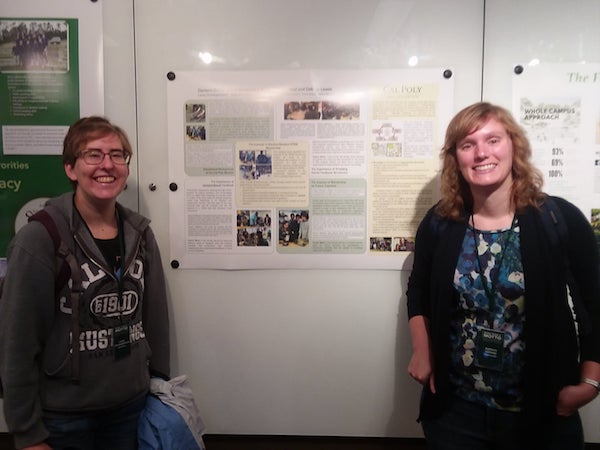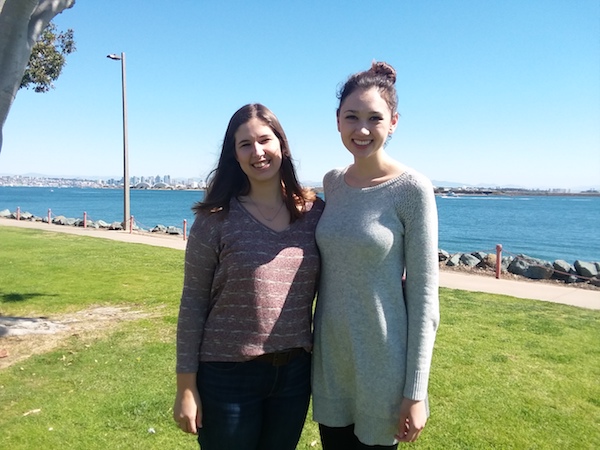Students Expand the Frontiers of Mathematics with Faculty Mentors
Student researchers and their faculty mentors explored mathematical concepts ranging from quadratic infinite trees to the Game of Life.
Eric Brussel with Patrick Kerrigan
A Simple Continuous Analogue of the ‘Game of Life’
During summer 2017 Eric Brussel and physics major Patrick Kerrigan attempted to construct a simple continuous analogue of the somewhat infamous “Game of Life,” a discrete time and space cellular automaton devised by John Conway. In trying to make the reverse-quantum-leap, there were several difficulties with how to interpret some of the rules of the original game of life, and Kerrigan attempted to put his own twist on some of the things that have already been done by others. Immediately Brussel and Kerrigan were confronted by questions: what sort of metric should be used to determine whether a transition should occur? Indeed, what does a “transition” even look like in this new formulation?
In the end, finding a transition function that allowed for both propagation of “life” and not immediate system collapse was never found, but a few stable states were coaxed into existence with various additional techniques, for example the stable cell in the figure below. Perhaps a more systematic exploration of the parameters involved could shed more light on this situation and find more interesting objects.
 This figure shows a stable “alive” cell, unable to move. This is a 1 spatial, 1 temporal dimension version of the ‘game,’ with the time parameter being the backwards direction, so that one can see the stable object persisting in time without moving on this plot. The periodic time displacements visible are from a driving oscillation that Kerrigan added to try to coax out some more movement, but ultimately this failed.
This figure shows a stable “alive” cell, unable to move. This is a 1 spatial, 1 temporal dimension version of the ‘game,’ with the time parameter being the backwards direction, so that one can see the stable object persisting in time without moving on this plot. The periodic time displacements visible are from a driving oscillation that Kerrigan added to try to coax out some more movement, but ultimately this failed.
Danielle Champney with Julia Gladding, Nicole Linman, Kathryn Voltmer, Lacey Christopher Maria Ramirez-Camacho, Evelyn Fox and Francis Britschgi
Content-Based Mentorship Program
Lacey Christophersen, Maria Ramirez-Camacho and Kathryn Voltmer worked on extensions of previous summers' projects, completing the final design of a content-based mentorship program. Cal Poly is implementing the program, which is in its third cycle, with partner Da Vinci Science High School in Hawthorne, Calif. The team also developed three research studies. Christophersen and Voltmer also presented a poster on their work during the 2017 Learn by Doing: More than a Motto Conference, and Ramirez-Camacho presented a poster and gave a research talk to prospective and current students and parents at the Cal Poly Mustang Family Weekend Showcase.


Understanding Students' Mathematical Development
 Julia Gladding and Nicole Linman developed and implemented a study designed to better understand students' mathematical development of three content-based strands that span from kindergarten through college. Their study included extensive development of tasks and protocols for collecting data on young students' mathematical thinking and understanding.
Julia Gladding and Nicole Linman developed and implemented a study designed to better understand students' mathematical development of three content-based strands that span from kindergarten through college. Their study included extensive development of tasks and protocols for collecting data on young students' mathematical thinking and understanding.
Their work transitioned into their senior project, and they were joined by Lindsay Nolte. The team of three has, in addition to pursuing their own research, developed a video library that showcases young students thinking along their identified strands, which coincides with the Math for Liberal Studies sequence of four courses offered to future teachers through the Mathematics Department.
The Effectiveness of a Classroom-Based System of Games
Statistics majors Francis Britschi and Evelyn Fox extended previous summers' research to design measures and means for studying the effectiveness of a classroom-based system of games being implemented in fifth grade classrooms. The classroom system is on its fourth cycle during the current academic year, and Britschi and Fox’s experimental design has guided data collection during this first non-pilot year of the system and curriculum.
Robert Easton with Chad Collins, Sam Lindbloom-Airey and Cruz Godar
A Tropical Analogue of the Classical Duality Map for Projective Plane Conics
Robert Easton led a group of Frost Research Fellows consisting of Chad Collins, Cruz Godar and Sam Lindbloom in an investigation into a tropical analogue of the classical duality map for projective plane conics. They ultimately showed that the straightforward tropical analogues of the duality do not lead to a true duality for tropical projective plane conics, but something closer to a partial duality.
Caixing Gu with Sean Gonzales, Perry Roeder and Codi Barnett
Quadratic infinite trees and 3-isometric composition operators.
Isometries are linear operators that preserve the length of vectors. In this project, we studied high order isometries. We focused on a class of composition operators that can be represented by infinite graphs. The branch growth properties of these graphs are closed related to the orders of the generalized isometries. If the graph has a quadratic growth, then we have a 3-isometry. By enumerating these graphs using several mathematical tools, we showed there are unaccountably many (unitarily non-equivalent) such 3-isometries. This is in contrast with the 2-isometries where there are only countably many such 2-isometries.
Erin Pearse and Tony Samuel with Elise Mihanovich, Elisabeth Esquivel, Blaine Quackenbush, Jordan Rowley, Matt West and Zoe Cooperband
The Topological Entropy of 1-Dimensional Dynamical Systems
Erin Pearse and Tony Samuel worked over the summer with Zoe Cooperband, Elisabeth Esquivel, Elise Mihanovich, Jordan Rowley, Blaine Quackenbush and Matt West. The research team studied the topological entropy of 1-dimensional dynamical systems (iteration of Lorenz maps). More specifically, they looked at a family of Lorenz maps with a single discontinuity and attempted to prove that entropy changes continuously as the point of discontinuity is varied.
Cooperband, Rowley, Quackenbush and West continued to work on the project through fall and winter quarters and presented their results at the Joint Mathematics Meeting poster session in January. The preprint is now complete and posted on arXiv.
Dylan Retsek with Scott Warnert
Abstract: Given a set S of functions we often ask
If ƒ and g are members of S and both enjoy property X, does ƒ◦g also enjoy property X?
When S is the set of functions from ℝ to ℝ and property X is continuity or differentiability, we answer this question affirmatively in calculus class.
In this project we considered the Hardy space Η² (ⅅ) of analytic functions on the open unit disk ⅅ in the complex plane whose Maclaurin coefficients are square-summable. Given analytic φ : ⅅ➞ⅅ, the composition operator Cφ on Η² (ⅅ); is then defined by Cφ = ƒ◦φ
Our program of research was to understand certain operator-theoretic properties of Cφ in terms of the geometric-function-theoretic properties of the map φ. In particular, the action of the operator Cφ on the reproducing kernels in Η² was fully classified for linear fractional symbols φ yielding some surprising results. The authors are currently preparing a manuscript for publication.
Student Teacher and Researcher (STAR) Program
 Nick Rubio participated in the Student Teacher and Researcher (STAR) Program during summer 2017. He worked with researchers and other future teachers at the Biosphere 2 Lab at the University of Arizona in Tucson. Rubio studied trends in the California drought and learned about research techniques and some applied mathematics techniques, while spending time with fellow participants thinking about how to utilize his new skills in his future high school mathematics classroom. Rubio’s advisor at University of Arizona was Guo-Yue Niu.
Nick Rubio participated in the Student Teacher and Researcher (STAR) Program during summer 2017. He worked with researchers and other future teachers at the Biosphere 2 Lab at the University of Arizona in Tucson. Rubio studied trends in the California drought and learned about research techniques and some applied mathematics techniques, while spending time with fellow participants thinking about how to utilize his new skills in his future high school mathematics classroom. Rubio’s advisor at University of Arizona was Guo-Yue Niu.
Academy of Inquiry Based Learning
Danielle Champney, Todd Grundmeier, Dylan Retsek and Stan Yoshinobu continued their work on supporting inquiry-based learning in college mathematics. Professional Development and Uptake through Collaborative Teams (PRODUCT). This project focuses on A main goal of PRODUCT is to expand the professional development capacity of the mathematics profession in delivering inquiry-based learning (IBL) methods in college math courses.
Co-led by Yoshinobu and Sandra Laursen at the University of Colorado, Boulder, the PRODUCT team includes 19 math professors across the nation in addition to the Cal Poly faculty members. In summer 2018, the entire team will conduct three workshops in Los Angeles, Washington, D.C. and Chicago, and several shorter workshops at math departments and regional conferences in North America.
The project is funded by a $2.8 million National Science Foundation grant. More information is available on the Academy of Inquiry Based Learning website.

